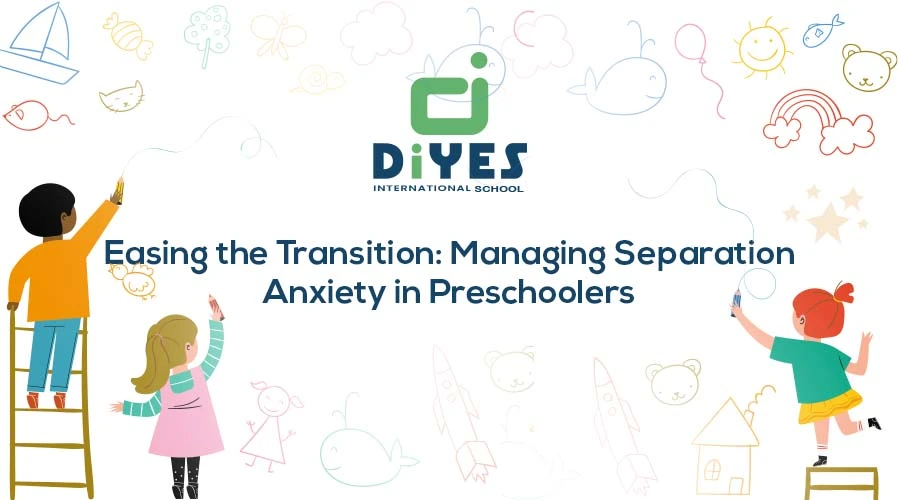For many preschoolers and their parents, the early days of school can be accompanied by separation anxiety. Understanding and addressing this common concern is crucial for a smooth transition to preschool.
In this blog, we will delve into separation anxiety in preschoolers, share strategies for both parents and educators, and emphasize the importance of a supportive and reassuring environment. By understanding the nature of separation anxiety, implementing supportive techniques, and fostering resilience and confidence, we aim to create a strong foundation for a child’s early school experience, setting the stage for a lifelong love of learning and growth.
Understanding Separation Anxiety
Separation anxiety is a natural phase for many preschoolers. In this section, we will explore the phenomenon of separation anxiety, its normalcy, and how parents and educators can navigate this phase effectively
- Recognizing the normalcy of separation anxiety: Separation anxiety is a common developmental phase that many preschoolers experience as they embark on their educational journey.

It’s essential for both parents and educators to understand that this anxiety is a natural part of a child’s growth and emotional development. During this phase, children often feel anxious or distressed when separated from their primary caregivers, usually their parents. Acknowledging the normalcy of this emotional response is the first step in addressing it effectively. Parents and teachers should be prepared to offer support and reassurance during this challenging period, knowing that it is a sign of attachment and emotional connection.
- Differentiating between typical and excessive anxiety: While separation anxiety is typical, it’s essential to distinguish between normal levels of distress and excessive anxiety that may require additional attention. It’s normal for a preschooler to experience some unease during separation, but excessive anxiety may manifest as extreme resistance to attending school, persistent crying, physical symptoms like stomach-aches or headaches, or significant disruptions to daily life. Parents and educators should remain attentive to these signs and work together to differentiate typical reactions from those that may need specialized support.
- Addressing the root causes of anxiety: To effectively manage separation anxiety in preschoolers, it’s crucial to identify and address the root causes triggering this emotional response. In some cases, past experiences or personal factors might contribute to a child’s anxiety. Open communication between parents, teachers, and the child can provide insights into these underlying causes, allowing for a more targeted approach to support and intervention. By understanding the unique needs and triggers of each child, parents and educators can tailor their strategies to help alleviate anxiety effectively.
How to Handle a Child with Separation Anxiety
Separation anxiety is a common and natural experience for many preschoolers, especially around the age of four. This stage of development can be challenging for both children and parents as youngsters grapple with the concept of separation from their caregivers.

Let’s delve into separation anxiety in preschoolers, specifically in four-year-olds, and discuss effective strategies to help both children and parents navigate this transitional phase. Understanding the nature of separation anxiety and implementing helpful techniques can make the process smoother and less stressful for everyone involved.
Here are some tips on how to handle a child with separation anxiety:
- Acknowledge Their Feelings: It’s essential to validate your child’s feelings of anxiety. Let them know that it’s okay to feel this way and that many children go through it. Reassure them that you understand and are there to support them.
- Create a Predictable Routine: Children thrive on routines, as they provide a sense of security. Establish a consistent morning and goodbye routine to make separations more predictable. Knowing what to expect can help ease anxiety.
- Practice Separations: Start with short separations and gradually increase the time apart. Leave your child with a trusted caregiver or at school for short periods and gradually extend the duration as they become more comfortable.
- Stay Calm and Positive: Children often pick up on their parents’ emotions. Stay calm and positive during the separation process. If you are anxious or upset, it can increase your child’s anxiety.
- Farewell Rituals: Create a special goodbye ritual with your child. It could be a secret handshake, a special hug, or a favourite phrase you exchange before parting. This ritual can provide comfort.
- Offer Reassurance: Reassure your child that you will return. Use phrases like, “I’ll be back soon” or “I’ll miss you, but I’ll see you later.” It’s essential to keep your promises when you return.
- Stay Brief: Prolonged goodbyes can make separation harder. Keep your farewells brief and avoid lingering. A quick and confident departure can help your child adjust more easily.
- Stay Connected: Some children benefit from staying connected during separation. You can send a small note or a picture via text or email. Knowing that you’re just a message away can provide comfort.
- Stay Informed: Communicate with your child’s caregiver or teacher about their behaviour during separation. They can provide insights into how your child is coping and offer support.
- Avoid Sneaking Away: While it may be tempting to slip away when your child is distracted, it’s better to say goodbye. Sneaking away can erode trust and increase anxiety.
- Create a Comfort Object: Sometimes, having a comfort object, like a favourite stuffed animal or blanket, can provide solace during separation.
- Involve Your Child: Involve your child in preparing for separation. Let them choose what to wear or pack in their backpack. Giving them some control can reduce anxiety.
- Seek Professional Help: If your child’s separation anxiety is severe and persistent, consider seeking professional help from a therapist or counsellor who specializes in child anxiety.
It’s important to keep in mind that each child is unique, and what proves effective for one may not yield the same results for another. Be patient and flexible in your approach, and most importantly, provide a lot of love and reassurance to help your child through this phase.
Strategies for Educators
Educators also play a crucial role in helping preschoolers manage separation anxiety. In this section, we’ll discuss strategies that teachers can employ to create a welcoming classroom environment and facilitate a smooth transition.

- Creating a welcoming and inclusive classroom: Educators play a crucial role in setting the tone for a positive school experience. A warm and inviting classroom environment can significantly ease separation anxiety. Teachers should establish a welcoming atmosphere where children feel safe and valued. Displaying their artwork, creating a cozy reading nook, and incorporating familiar elements from home can help children feel more comfortable and connected to the classroom.
- Implementing a gradual separation approach: A gradual separation approach is an effective strategy for educators. This involves allowing parents to stay with their child in the classroom for a brief period during the initial days, gradually reducing the time spent together. This gentle transition gives preschoolers the opportunity to acclimate to the new environment at their own pace while knowing that their parents are nearby for support. Over time, as the child becomes more comfortable, parents can leave for longer intervals until their child is confidently independent in the classroom.
- Communicating openly with parents: Collaboration between educators and parents is essential in managing separation anxiety. Teachers should maintain open lines of communication with parents, sharing insights into a child’s behaviour and emotional progress at school. Regular updates and feedback help parents understand their child’s experiences, allowing them to offer appropriate support at home. Educators can also provide parents with resources and guidance on managing separation anxiety effectively.
Building Resilience and Confidence
Building resilience and confidence is a crucial aspect of managing separation anxiety. In this section, we’ll explore strategies that both parents and educators can implement to empower children during this phase.
- Fostering independence through age-appropriate tasks: Preschool is an ideal time to foster independence and self-confidence. Educators can encourage children to engage in age-appropriate tasks, such as putting away their belongings, choosing activities, or helping with simple classroom chores. These experiences empower children to feel capable and confident in their abilities.
- Celebrating small victories and milestones: Recognizing and celebrating each child’s achievements, no matter how small, is crucial for building confidence. Whether it’s successfully completing a puzzle, making a new friend, or participating in a group activity, acknowledging these accomplishments reinforces a child’s self-esteem and encourages them to embrace new challenges.
- Nurturing a sense of belonging and security: Creating a sense of belonging is fundamental to alleviating separation anxiety. Educators can foster a supportive classroom community where children feel accepted, valued, and secure. Encouraging teamwork, empathy, and inclusivity helps children form positive relationships with peers, further enhancing their sense of belonging and emotional security.
Conclusion
In conclusion, the phenomenon of separation anxiety in preschoolers is a natural and expected phase in a child’s development. It’s essential for both parents and educators to recognize that this anxiety is a sign of a strong emotional bond between the child and their caregivers. By understanding the normalcy of separation anxiety and differentiating between typical and excessive manifestations, we can better address the needs of our young learners.
For parents, acknowledging and validating a child’s feelings, establishing predictable routines, and offering reassurance are powerful tools for helping children cope with separation anxiety. Moreover, creating special goodbye rituals, staying connected, and involving the child in preparations can ease the transition.
Educators, too, play a pivotal role by creating welcoming and inclusive classroom environments and implementing gradual separation approaches. Open communication with parents is crucial for providing insights into a child’s progress and behaviour at school.
Furthermore, building resilience and confidence in preschoolers is key to managing separation anxiety effectively. Encouraging independence through age-appropriate tasks, celebrating small victories, and nurturing a sense of belonging and security all contribute to a child’s emotional well-being and ability to thrive in a school environment.
At DiYES International School, we understand the significance of nurturing each child’s emotional well-being. Our experienced educators and staff are dedicated to creating a welcoming and inclusive environment, ensuring that the preschool experience is positive and reassuring.To learn how DiYES International School supports children and families through this transition and offers a nurturing preschool environment, please visit our website at www.diyesinternational.edu.in or contact us directly at +91 8547609000.


